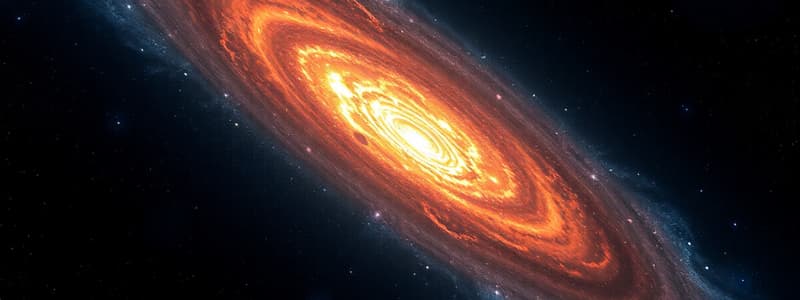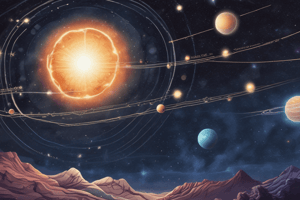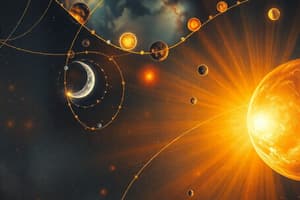Podcast
Questions and Answers
A star is observed to have a high luminosity and a relatively cool surface temperature. According to the Hertzsprung-Russell diagram, what type of star is it most likely to be?
A star is observed to have a high luminosity and a relatively cool surface temperature. According to the Hertzsprung-Russell diagram, what type of star is it most likely to be?
A star has a high apparent magnitude. What can be inferred about the star?
A star has a high apparent magnitude. What can be inferred about the star?
How does the mass of a star influence its life cycle?
How does the mass of a star influence its life cycle?
Which of the following statements is true regarding stellar spectral types?
Which of the following statements is true regarding stellar spectral types?
Signup and view all the answers
A star exhibits a small parallax angle. What does this indicate about its distance from Earth?
A star exhibits a small parallax angle. What does this indicate about its distance from Earth?
Signup and view all the answers
What is the primary factor that determines the main sequence lifetime of a star?
What is the primary factor that determines the main sequence lifetime of a star?
Signup and view all the answers
Which of the following is a key difference between a red giant and a red supergiant?
Which of the following is a key difference between a red giant and a red supergiant?
Signup and view all the answers
After a star exhausts its nuclear fuel, it may become a white dwarf, a neutron star, or a black hole. What primary characteristic of the star determines this final stage?
After a star exhausts its nuclear fuel, it may become a white dwarf, a neutron star, or a black hole. What primary characteristic of the star determines this final stage?
Signup and view all the answers
Flashcards
Stellar Characteristics
Stellar Characteristics
Stars are massive luminous spheres of plasma, held by gravity.
Nuclear Fusion
Nuclear Fusion
Process where stars produce light and heat in their cores.
Morgan-Keenan System
Morgan-Keenan System
A common classification system for stars based on spectral type.
Main Sequence
Main Sequence
Signup and view all the flashcards
Red Giant
Red Giant
Signup and view all the flashcards
Apparent Magnitude
Apparent Magnitude
Signup and view all the flashcards
Parallax
Parallax
Signup and view all the flashcards
Luminosity
Luminosity
Signup and view all the flashcards
Study Notes
Stellar Characteristics
- Stars are massive, luminous spheres of plasma held together by their own gravity.
- They produce light and heat through nuclear fusion in their cores.
- The life cycle of a star depends primarily on its mass.
- Stars vary significantly in size, temperature, and brightness.
Stellar Classification
- Astronomers categorize stars based on their spectral type, which is linked to their surface temperature.
- The most common spectral classification system is the Morgan-Keenan (MK) system.
- Spectral types are ordered from hottest to coolest: O, B, A, F, G, K, M.
- Each spectral type is further subdivided into subtypes, such as O5, B0, A0, etc.
- Stars of different types have distinct colors, ranging from blue for the hottest to red for the coolest.
Stellar Evolution
- Stars form from collapsing clouds of gas and dust, known as nebulae.
- The initial stage of a star's life is its protostar phase, where it gradually gathers more matter.
- A star spends most of its life in a stable phase, known as the main sequence, where it fuses hydrogen atoms into helium.
- The main sequence lifetime of a star is primarily determined by its mass. More massive stars evolve and burn through their fuel much faster.
- When a star runs low on hydrogen fuel, its core contracts, and its outer layers expand and cool, transforming it into a red giant or red supergiant.
- Depending on the star's mass, it will evolve into different types of stellar remnants.
- Low-mass stars like the Sun become white dwarfs.
- Medium-mass stars like the Sun undergo a planetary nebula phase, shedding their outer layers and leaving behind a white dwarf.
- High-mass stars become supergiants and eventually explode as supernovae, leaving behind neutron stars or black holes.
Stellar Brightness
- The apparent brightness of a star, as seen from Earth, is called its apparent magnitude.
- Absolute magnitude is a measure of a star's intrinsic luminosity, the total amount of energy it emits per second.
- The apparent magnitude of a star depends on its distance from Earth.
- More luminous and closer stars have higher apparent magnitudes.
- A star's luminosity is directly related to its surface temperature and radius.
Stellar Distances
- Distances to stars are often measured in parsecs or light-years.
- Parallax is a method to measure the distances to nearby stars.
- For greater distances, other methods such as spectroscopic parallax and standard candles are used.
- The farther away a star is, the smaller its angular shift will be.
Other Important Stellar Characteristics
- Binary and multiple star systems are common, with two or more stars orbiting a common center of mass.
- Some stars exhibit variability in their brightness, either due to intrinsic changes in their properties.
- Variable stars are often used in astronomy to measure distances to other galaxies.
- Eruptive phenomena, such as flares, can occur on the surface of stars.
- Starspots are regions of cooler temperatures on the surfaces of stars, analogous to sunspots on the Sun.
- Stellar winds are streams of charged particles that flow outwards from a star.
Studying That Suits You
Use AI to generate personalized quizzes and flashcards to suit your learning preferences.
Description
Explore the characteristics, classification, and evolution of stars. Learn about stellar properties such as mass, temperature, and brightness. Discover the Morgan-Keenan (MK) system.




